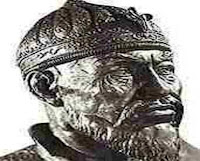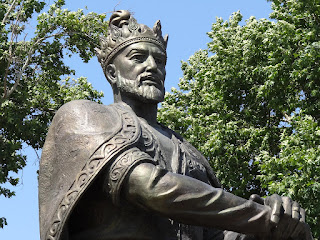Unfortunately,
History has been much distorted by many historians and still very least and almost
none knows exactly about the greatest conqueror of all time. If you are lived
in Europe, you probably think about Alexander the Great and if you are lived in Asia, you probably think about Genghis Khan. But actually, Truth is far different than most people expected. Same as many people do not know precisely about the greatest military commander, military campaigner, and warlord in history.
"There is only one God (Allah) in the sky (Universe), and there should be only one king on the earth, the whole world does not deserve to have more than one king". (Timur)

Timur "Iron" (known in the West as Tamerlane, which derives from the Persian word "Taimur the Lame", pejorative term) was Turko-Mongol ruler, founder of the Timurid Empire and its dynasty. He is undoubtedly the greatest military campaigner, military commander, warlord, and conqueror of all time. This is the actual fact, we are going to share with you right now and unveiled the truth which has never been fully described before or even in today's era. We explained one by one all of its features as a Conqueror, Military Commander, Military Campaigner, and Warlord to distinguish his undisputed positions on top of every competitor.
Conqueror: Without any shadow of a doubt, Timur is the greatest conqueror of all time. His colossal conquest dwarfs every other conqueror. Due to his iron will and sheer strategies, he conquered the entire landmass of Eurasia from Moscow to Delhi and from Damascus to Turpan.
Unlike Genghis Khan, Timur wasn't relied on his generals to conquer the empires; he almost personally led his military campaigns against enemies wherever he went. As a conqueror, he conquered lands more than anyone else in history; his extraordinary conquest (17,000,000 km2) included the entire regions of Central Asia (Kazakhstan, Uzbekistan, Turkmenistan, Tajikistan), Transcaucasia (Georgia, Armenia, Azerbaijan), Mogulistan/Xinjiang (Western China), Modern day entire countries of Afghanistan, Pakistan, Iran, Iraq, Syria, Lebanon, Kuwait, Israel (except Southern parts), Turkey (except Byzantine Pontus), Northwestern parts of India, parts of Western Mongolia and Eastern Ukraine and much of Russia (Southern regions of entire European Russia and much of Western Siberia).
On the contrary,
Genghis Khan didn’t personally conquer every state/empire that brought into
his massive empire, even he not fully conquered the Jin and Khwarezmian Empire; his son and successor Ogedei completed the entire conquest of both Jin
and the Khwarezmian Empire after his death. Even his huge
Mongol Empire (12,000,000 km2), in which more than half of his territory was annexed/occupied by his son Jochi (Siberian lands) and two
most formidable commanders Subutai (lands of the Cuman-Kipchak Confederation around Kazakhstan) and Jebe (Land of Kara Khatai Khanate in Sinkiang, Western China). Genghis Khan sent his son Jochi to conquer the forest people of Siberia (2,000,000 km2) in 1207 AC, he annexed the entire region up to the Tuva, all tribes were submitted with little resistance except Yenisei Kyrgyz and far eastern regions of Siberia (800,000 km2) around the Pacific Ocean were probably conquered by either Jochi or Subutai as part of the Mongol Empire's expansion and Subutai under the orders of Genghis Khan invaded Central Kazakhstan (1217-1220) to defeat the Merkits and their Cuman-Kapchak allies, he occupied the entire area up to the Caspian Sea (2,200,000 km2) in Western Kazakhstan and in 1218 Jebe invaded and conquered the entire domain of Kara-Khitan
Khanate (1,500,000 km2) up to the region of Lake Balkhash in eastern Kazakhstan. Like Timur; Cyrus the Great, Alexander the Great, Attila the Hun, Mahmud of Ghazni, and Nader Shah
of Persia were also personally led his military campaigns wherever they went but
their conquests have no match with Timur. They all conquered lands around 4 to 5.5 million km2.

Military Commander: Timur remained undefeated in his entire military career that covers more than four decades (1360-1405 AD) despite facing constant wars, in which he fought at least two hundred battles, conquered much of Asia, Eastern Europe, and overwhelmed all his rivals in Asia (except Ming China), Africa, and Europe.
Timur and his army defeated and subdued all of his opponents in the world (Grand Duchy of Lithuania, Ottoman Empire of Turkey, Mamluke Empire of Egypt, Delhi Sultanate of India, Crusaders/Knight Hospitallers of Smyrna (Izmir, Turkey), Kingdom of Georgia and all the remnants of the former Mongol Empire i.e. Chagatai Khanate of Central Asia, Yuan khanate of Mongolia, Il-khanate of Persia, Golden Horde khanate of Russia). Only the Ming Empire of China survived because Timur died from fever while he was on his way to conquer the last great empire that stood in his way of complete world domination. From the coldest regions of Siberia to the hottest regions of India and from the scorching heat of the deserts of Iraq to the lacerating cold weathers of Georgia or the notorious mountains of Hindu Kush regions of Afghanistan, whatever the conditions will be, Timur remained unstoppable and unchecked by any military or any obstacles. Siege of Birtvisi and Smyrna (1403), Battle of Ankara (1402), Siege of Aleppo and Damascus (1400), Battle of Delhi (1398), Battle of Terek River (1395), Battle of Kondurcha River (1390), Siege of Tbilisi (1386), Siege of Urganj (1380), Battle of Balkh (1370) was the sign of his strategic and tactical victories.
No
doubt Alexander the Great, Khalid bin Al-Waleed, Subutai, Alexander Suvorov, and Napoleon Bonaparte were great commanders but their victories in terms of
countable battles and their influence or conquest are far lesser than Timur. For
example, Khalid bin Al-Waleed, Subutai, and Alexander Suvorov remained undefeated in 100, 65, and 63 battles respectively. Alexander the Great fought in between 25 to 50 battles (both minor skirmishes and major battles plus sieges) to remain undefeated. Napoleon Bonaparte fought 60 battles and losing 8 (generally at the end of his military career). On the
contrary, Tamerlane (Timur) managed to remain undefeated in more than at least two hundred battles plus
his conquest outstretched any other opponents and his influence reaches from Spain to China as a result of their military achievements.
Military Campaigner: From 1370 to 1405 CE, Emir Timur constantly involves in far-flung military campaigns spreading from Israel to China and from Russia to India is a testimony to his marvelous feat of accomplishment, enduring every single obstacle.
On many occasions, Timur personally commands his troops to cover thousands of miles away from his capital at Samarkand to meet their enemies in battle. For example like in the battle of Kundurcha River (1390) in which he defeated Tokhtamysh, khan of the Golden Horde and penetrated far deeper into the Siberian lands for more than 700 miles of the uninhabited region then west about 1000 miles, advancing in a front more than 10 miles
wide and met the forces of Tartar Golden Horde and defeated them. Second, during the battle of Terek River, he once again traveled far deeper into the Russian land and reaches Ukraine. In a manner of just more than five years (1390-1396), Timur launches two major military campaigns into the coldest inhabitant regions of the earth (Siberia and European Russia) and also into one of the coldest and toughest mountainous regions of the earth (Caucasus), in which he successfully conquered parts of western Siberia, European Russia, Ukraine, and the Caucasus, defeated/subdued all rivals in their path i.e. Tatar Golden Horde, Italian colonies of Genoese and Venetians, Spanish colonies of Catalans and Biscay, Volga Bulgars, Russian Principalities of Moscow and Ryazan, Caucasian states of Georgia and Armenia and cover thousands of miles to achieve all this glory. Especially his last military campaign was extraordinarily
successful in which he covered 10 million km2 distance from Samarkand to the Mediterranean Sea and vice versa (including his Zigzag movements as well) to defeat all rivals in their track; Georgians, Armenians,
Crusaders, Ottoman Turks, Egyptian Mumlukes, and Arabs in just more than four years of his military campaign (1399-1404). In History, no one's army or his commander able to achieve these feats without losing any of his pitched battles and conquered huge chunks of an area in a course of a just few years. Only Subutai rival Timur in that sense because of his 20 major campaigns brought enormous success for Mongols without losing any of his single battles and overran or conquered Northern China, Central Asia, Eastern, and Central Europe. But even his extensive campaigns unable to surpass the behemoth conquest and unstoppable far-flung military campaigns of Timur the Great. Timur's conquest/military campaigns extended from the Ming Great Wall (Jiayu Pass, China) in the east to the Dome of the Rock (Jerusalem, Israel) in the west and from the Church of all Saints (Moscow, Russia) in the north to the Qutub Minar (Delhi, India) in the south and left no great powers except Ming China which survived because of Timur's death while he was on his way towards his final task.




No comments:
Post a Comment